Transition to Low-Carbon Hydrogen Energy System in the UAE: Sector Efficiency and Hydrogen Energy Production Efficiency Analysis
Abstract
:1. Introduction
Hydrogen Potential of the UAE
2. Low-Carbon Hydrogen Energy
3. Sector Coupling
4. Analysis Framework
5. Data Envelopment Analysis Efficiency Estimation
6. Results and Discussions
Hydrogen Transition Framework for the UAE
7. Summary and Conclusions
Author Contributions
Funding
Data Availability Statement
Conflicts of Interest
References
- UAE. The UAE’s Response to Climate Change. Available online: https://u.ae/en/information-and-services/environment-and-energy/climate-change/theuaesresponsetoclimatechange#:~:text=Clean%20fossil%20fuels-,UAE%20Net%20Zero%202050,MENA)%20nation%20to%20do%20so (accessed on 29 June 2022).
- UNFCCC. The Paris Agreement. Available online: https://unfccc.int/process-and-meetings/the-paris-agreement/the-paris-agreement (accessed on 29 June 2016).
- IEA. Energy Transition Indicators. Available online: https://www.iea.org/countries/united-arab-emirates (accessed on 29 June 2019).
- Ghaffour, N.; Reddy, V.; Abu-Arabi, M. Technology development and application of solar energy in desalination: MEDRC contribution. Renew. Sustain. Energy Rev. 2011, 15, 4410–4415. [Google Scholar] [CrossRef]
- Hanley, E.S.; Deane, J.; Gallachóir, B.Ó. The role of hydrogen in low carbon energy futures–A review of existing perspectives. Renew. Sustain. Energy Rev. 2018, 82, 3027–3045. [Google Scholar] [CrossRef]
- Rissman, J.; Bataille, C.; Masanet, E.; Aden, N.; Morrow, W.R.; Zhou, N.; Elliott, N.; Dell, R.; Heeren, N.; Huckestein, B.; et al. Technologies and policies to decarbonize global industry: Review and assessment of mitigation drivers through 2070. Appl. Energy 2020, 266, 114848. [Google Scholar]
- Sarı, A.; Sulukan, E.; Özkan, D.; Uyar, T.S. Environmental impact assessment of hydrogen-based auxiliary power system onboard. Int. J. Hydrogen Energy 2021, 46, 29680–29693. [Google Scholar] [CrossRef]
- European Comission. Environmental Impacts of Hydrogen-based Energy Systems. October 2006. Available online: https://ec.europa.eu/environment/integration/research/newsalert/pdf/39na1_en.pdf (accessed on 27 July 2021).
- Noussan, M.; Raimondi, P.P.; Scita, R.; Hafner, M. The Role of Green and Blue Hydrogen in the Energy Transition—A Technological and Geopolitical Perspective. Sustainability 2020, 13, 298. [Google Scholar] [CrossRef]
- YiDou. Chapter 10—Opportunities and Future Challenges in Hydrogen Economy for Sustainable Development. Hydrogen Econ. 2017, 277–305. [Google Scholar] [CrossRef]
- FCH. Hydrogen Roadmap Europe: A Sustainable Pathway for the European Energy Transition; Fuel Cells and Hydrogen: Luxembourg, 2019. [Google Scholar]
- Adam, P.; Heunemann, F.; von dem Bussche, C.; Engelshove, S.; Thiemann, T. Hydrogen infrastructure—The pillar of energy transition. Siemens Energy Conf. Eur. Comm. 2020. Available online: https://www.gascade.de/fileadmin/downloads/wasserstoff/whitepaper-h2-infrastructure.pdf (accessed on 24 July 2022).
- Espegren, K.; Damman, S.; Pisciella, P.; Graabak, I.; Tomasgard, A. The role of hydrogen in the transition from a petroleum economy to a low-carbon society. Int. J. Hydrogen Energy 2021, 46, 23125–23138. [Google Scholar] [CrossRef]
- He, G.; Mallapragada, D.S.; Bose, A.; Heuberger-Austin, C.F.; Gençer, E. Sector coupling via hydrogen to lower the cost of energy system decarbonization. Energy Environ. Sci. 2021, 14, 4635–4646. [Google Scholar] [CrossRef]
- UAE. UAE Energy Strategy 2050; United Arab Emirates Government: Abu Dhabi, United Arab Emirates, 2021.
- Lin, M.T. UAE Wants to Transform from a Petrostate to Renewable and Hydrogen Powerhouse; 2022; Available online: https://www.bloomberg.com/news/articles/2021-01-19/uae-can-be-major-low-cost-blue-hydrogen-producer-adnoc-ceo-says (accessed on 24 July 2022).
- Adams, A. Net Zero with Hydrogen is on the Horizon, We Need the World on Board to Get There. Available online: https://hydrogencouncil.com/en/net-zero-with-hydrogen-is-on-the-horizon-we-need-the-world-on-board-to-get-there/ (accessed on 27 July 2021).
- UAE. UAE Targets 25% of Hydrogen Market by 2030. Available online: https://www.energyconnects.com/news/renewables/2021/november/uae-targets-25-of-hydrogen-market-by-2030/ (accessed on 27 July 2021).
- ADNOC. Hydrogen; ADNOC. 2022. Available online: https://adnoc.ae/en/news-and-media/press-releases/2022/adnoc-expands-strategic-partnerships-across-the-hydrogen-value-chain-with-leading-german-companies (accessed on 24 July 2022).
- ADNOC. ADNOC to Build World-Scale Blue Ammonia Project. Available online: https://www.adnoc.ae/news-and-media/press-releases/2021/adnoc-to-build-world-scale-blue-ammonia-project (accessed on 27 July 2021).
- Hebert, J. Bee’ah and Chinook to work on UAE hydrogen first. Proj. Financ. 2021. [Google Scholar]
- Friedmann, J.; Mills, R. The Uae’s Role in the Global Hydrogen Economy; Qamar Energy: Dubai, United Arab Emirates; Available online: https://www.qamarenergy.com/sites/default/files/The%20UAE%27s%20Role%20in%20the%20Global%20Hydrogen%20Economy.pdf (accessed on 24 July 2021).
- Joubi, A.; Akimoto, Y.; Okajima, K. A Production and Delivery Model of Hydrogen from Solar Thermal Energy in the United Arab Emirates. Energies 2022, 15, 4000. [Google Scholar] [CrossRef]
- Joubi, A.; Akimoto, Y.; Okajima, K. Catching the hydrogen train: Economics-driven green hydrogen adoption potential in the United Arab Emirates. Int. J. Hydrogen Energy 2022, 47, 22285–22301. [Google Scholar]
- DubaiFuture. Hydrogen: From Hype to Reality; Dubai Future Foundation: Duabi, United Arab Emirates, 2021. [Google Scholar]
- IEA. The Future of Hydrogen. Available online: https://www.iea.org/reports/the-future-of-hydrogen (accessed on 27 July 2018).
- Halff, A.; Mills, R. UAE to Play Leading Role in Emerging Global Hydrogen Market. Available online: https://www.ceoforlifeawards.com/blog/uae-to-play-leading-role-in-emerging-global-hydrogen-market/ (accessed on 27 July 2018).
- Calnan, S.; Bagacki, R.; Bao, F.; Dorbandt, I.; Kemppainen, E.; Schary, C.; Schlatmann, R.; Leonardi, M.; Lombardo, S.A.; Milazzo, R.G.; et al. Development of various photovoltaic-driven water electrolysis technologies for green solar hydrogen generation. Solar RRL 2022, 6, 2100479. [Google Scholar] [CrossRef]
- Downs, D.E.; Halff, A.; Mills, R. Having It Both Ways; Center for Global Energ Policy, Columbia University CGEP: New York, NY, USA, 2021. [Google Scholar]
- Kazim, A. Strategy for a sustainable development in the UAE through hydrogen energy. Renew. Energy 2010, 35, 2257–2269. [Google Scholar] [CrossRef]
- Eveloy, V.; Gebreegziabher, T. Excess electricity and power-to-gas storage potential in the future renewable-based power generation sector in the United Arab Emirates. Energy 2019, 166, 426–450. [Google Scholar] [CrossRef]
- Charnes, A.; Cooper, W.W.; Rhodes, E. Measuring the efficiency of decision making units. Eur. J. Oper. Res. 1978, 2, 429–444. [Google Scholar] [CrossRef]
- Farrell, M.J. The measurement of productive efficiency. J. R. Stat. Soc. Ser. A 1957, 120, 253–281. [Google Scholar] [CrossRef]
- Kara, S.; Ibrahim, M.; Daneshvar, S. Dual efficiency and productivity analysis of renewable energy alternatives of OECD countries. Sustainability 2021, 13, 7401. [Google Scholar] [CrossRef]
- Mei, M.; Chen, Z. Evaluation and selection of sustainable hydrogen production technology with hybrid uncertain sustainability indicators based on rough-fuzzy BWM-DEA. Renew. Energy 2021, 165, 716–730. [Google Scholar] [CrossRef]
- Chi, Y.; Xiao, M.; Pang, Y.; Yang, M.; Zheng, Y. Financing Efficiency Evaluation and Influencing Factors of Hydrogen Energy Listed Enterprises in China. Energies 2022, 15, 281. [Google Scholar] [CrossRef]
- Huang, Y.-S.; Liu, S.-J. Chinese green hydrogen production potential development: A provincial case study. IEEE Access 2020, 8, 171968–171976. [Google Scholar] [CrossRef]
- Ishaq, H.; Dincer, I. Comparative assessment of renewable energy-based hydrogen production methods. Renew. Sustain. Energy Rev. 2021, 135, 110192. [Google Scholar] [CrossRef]
- Nader, S. Paths to a low-carbon economy—The Masdar example. Energy Procedia 2009, 1, 3951–3958. [Google Scholar] [CrossRef]
- Gielen, D.; Boshell, F.; Saygin, D.; Bazilian, M.D.; Wagner, N.; Gorini, R. The role of renewable energy in the global energy transformation. Energy Strategy Rev. 2019, 24, 38–50. [Google Scholar] [CrossRef]
- Niaz, S.; Manzoor, T.; Pandith, A.H. Hydrogen storage: Materials, methods and perspectives. Renew. Sustain. Energy Rev. 2015, 50, 458–469. [Google Scholar] [CrossRef]
- Fan, J.-L.; Zhang, Y.-J.; Wang, B. The impact of urbanization on residential energy consumption in China: An aggregated and disaggregated analysis. Renew. Sustain. Energy Rev. 2017, 75, 220–233. [Google Scholar] [CrossRef]
- Guilbert, D.; Vitale, G. Hydrogen as a Clean and Sustainable Energy Vector for Global Transition from Fossil-Based to Zero-Carbon. Clean Technol. 2021, 3, 51. [Google Scholar] [CrossRef]
- Yu, M.; Wang, K.; Vredenburg, H. Insights into low-carbon hydrogen production methods: Green, blue and aqua hydrogen. Int. J. Hydrogen Energy 2021, 46, 21261–21273. [Google Scholar] [CrossRef]
- Khan, M.H.A.; Daiyan, R.; Neal, P.; Haque, N.; MacGill, I.; Amal, R. A framework for assessing economics of blue hydrogen production from steam methane reforming using carbon capture storage & utilisation. Int. J. Hydrogen Energy 2021, 46, 22685–22706. [Google Scholar]
- Boretti, A.; Banik, B.K. Advances in hydrogen production from natural gas reforming. Adv. Energy Sustain. Res. 2021, 2, 2100097. [Google Scholar] [CrossRef]
- Antonini, C.; Treyer, K.; Streb, A.; Van Der Spek, M.W.; Bauer, C.; Mazzotti, M. Hydrogen production from natural gas and biomethane with carbon capture and storage–A techno-environmental analysis. Sustain. Energy Fuels 2020, 4, 2967–2986. [Google Scholar] [CrossRef]
- Ursúa, A.; Sanchis, P. Static–dynamic modelling of the electrical behaviour of a commercial advanced alkaline water electrolyser. Int. J. Hydrogen Energy 2012, 37, 18598–18614. [Google Scholar] [CrossRef]
- International Energy Agency. The Future of Hydrogen; International Energy Agency: Paris, France, 2019. [Google Scholar]
- Lu, Y.; Pesch, T.; Benigni, A. Simulation of Coupled Power and Gas Systems with Hydrogen-Enriched Natural Gas. Energies 2021, 14, 7680. [Google Scholar] [CrossRef]
- Clegg, S.; Mancarella, P. Integrated modeling and assessment of the operational impact of power-to-gas (P2G) on electrical and gas transmission networks. IEEE Trans. Sustain. Energy 2015, 6, 1234–1244. [Google Scholar] [CrossRef]
- Ramsebner, J.; Haas, R.; Ajanovic, A.; Wietschel, M. The sector coupling concept: A critical review. Wiley Interdiscip. Rev. Energy Environ. 2021, 10, e396. [Google Scholar] [CrossRef]
- Rehman, O.A.; Palomba, V.; Frazzica, A.; Cabeza, L.F. Enabling Technologies for Sector Coupling: A Review on the Role of Heat Pumps and Thermal Energy Storage. Energies 2021, 14, 8195. [Google Scholar] [CrossRef]
- Mirzaei, M.A.; Nazari-Heris, M.; Zare, K.; Mohammadi-Ivatloo, B.; Marzband, M.; Asadi, S.; Anvari-Moghaddam, A. Evaluating the impact of multi-carrier energy storage systems in optimal operation of integrated electricity, gas and district heating networks. Appl. Therm. Eng. 2020, 176, 115413. [Google Scholar] [CrossRef]
- Wei, M.; McMillan, C.A. Electrification of industry: Potential, challenges and outlook. Curr. Sustain. Renew. Energy Rep. 2019, 6, 140–148. [Google Scholar] [CrossRef]
- Child, M.; Koskinen, O.; Linnanen, L.; Breyer, C. Sustainability guardrails for energy scenarios of the global energy transition. Renew. Sustain. Energy Rev. 2018, 91, 321–334. [Google Scholar] [CrossRef]
- Nuffel, L.V.; Dedecca, J.G.; Smit, T.; Rademaekers, K. Sector Coupling: How Can It Be Enhanced in the EU to Foster Grid Stability and Decarbonise? Policy Department for Economic, Scientific and Quality of Life Policies, European Parliament: Brussels, Belgium, 2018. [Google Scholar]
- Rabiee, A.; Keane, A.; Soroudi, A. Green hydrogen: A new flexibility source for security constrained scheduling of power systems with renewable energies. Int. J. Hydrogen Energy 2021, 46, 19270–19284. [Google Scholar] [CrossRef]
- IRENA. Sector Coupling in Facilitating Integration of Variable Renewable Energy in Cities; International Renewable Energy Agency (IRENA): Abu Dhabi, United Arab Emirates, 2021. [Google Scholar]
- Gils, H.C.; Simon, S.; Soria, R. 100% Renewable Energy Supply for Brazil—The Role of Sector Coupling and Regional Development. Energies 2017, 10, 1859. [Google Scholar] [CrossRef]
- IEA. ETP Model 2017; IEA: Paris, France, 2020. [Google Scholar]
- FCSC. Data Related to Gross Domestic Product, Consumer Price Index, Trade, Investment and Other Related Datasets; FCSC: London, UK, 2020.
- IEA. United Arab Emirates; IEA: Paris, France, 2019. [Google Scholar]
- Fong, W.; Sun, Y.; Chen, Y. Examining the Relationship between Energy Consumption and Unfavorable CO2 Emissions on Sustainable Development by Going through Various Violated Factors and Stochastic Disturbance–Based on a Three-Stage SBM-DEA Model. Energies 2022, 15, 569. [Google Scholar] [CrossRef]
- Xu, T.; You, J.; Li, H.; Shao, L. Energy efficiency evaluation based on data envelopment analysis: A literature review. Energies 2020, 13, 3548. [Google Scholar] [CrossRef]
- IEA. IEA World Energy Balances. Available online: https://www.iea.org/data-and-statistics/data-product/world-energy-statistics-and-balances (accessed on 15 July 2022).
- FCSC. Distribution of Gross Domestic Product at Constant (2010) Prices By Economic Activities. Available online: https://fcsc.gov.ae/en-us (accessed on 13 July 2022).
- Brauner, G. Efficiency Through Sector Coupling. In System Efficiency by Renewable Electricity; Springer: Berlin/Heidelberg, Germany, 2022; pp. 209–224. [Google Scholar]
- Xie, B.-C.; Tan, X.-Y.; Zhang, S.; Wang, H. Decomposing CO2 emission changes in thermal power sector: A modified production-theoretical approach. J. Environ. Manag. 2021, 281, 111887. [Google Scholar] [CrossRef] [PubMed]
- Ma, D.; Xiong, H.; Zhang, F.; Gao, L.; Zhao, N.; Yang, G.; Yang, Q. China’s industrial green total-factor energy efficiency and its influencing factors: A spatial econometric analysis. Environ. Sci. Pollut. Res. 2022, 29, 18559–18577. [Google Scholar] [CrossRef]
- Chambers, R.G.; Chung, Y.; Färe, R. Benefit and distance functions. J. Econ. Theory 1996, 70, 407–419. [Google Scholar] [CrossRef]
- Chung, Y.H.; Färe, R.; Grosskopf, S. Productivity and undesirable outputs: A directional distance function approach. J. Environ. Manag. 1997, 51, 229–240. [Google Scholar] [CrossRef]
- Álvarez, I.C.; Barbero, J.; Zofío, J.L. A data envelopment analysis toolbox for MATLAB. J. Stat. Softw. 2020, 95, 1–49. [Google Scholar] [CrossRef]
- NREL. H2A: Hydrogen Analysis Production Models. Available online: https://www.nrel.gov/hydrogen/h2a-production-models.html (accessed on 30 June 2022).
- UK. UK Hydrogen Strategy; Secretary of State for Business, Energy & Industrial Strategy: London, UK, 2021.
- The German Government. The National Hydrogen Strategy; Division, P.R., Ed.; Federal Ministry for Economic Affairs and Energy: Berlin, Germany, 2020; Available online: https://www.bmwk.de/Redaktion/EN/Publikationen/Energie/the-national-hydrogen-strategy.pdf?__blob=publicationFile&v=6 (accessed on 24 July 2022).
- UNECE. Draft Roadmap for Production and Use of Hydrogen in Ukraine. Available online: https://unece.org/sites/default/files/2021-03/Hydrogen%20Roadmap%20Draft%20Report_ENG%20March%202021.pdf (accessed on 8 August 2021).
- De Blasio, N.; Hua, C.; Nuñez-Jimenez, A. Sustainable Mobility: Renewable Hydrogen in the Transport Sector. Environ. Nat. Resour. Program Policy Briefs 2021. Available online: https://www.belfercenter.org/sites/default/files/2021-06/HydrogenPB3.pdf (accessed on 24 July 2022).
- EC. Powering a Climate-Neutral Economy: Commission Sets out Plans for the Energy System of the Future and Clean Hydrogen. Available online: https://ec.europa.eu/commission/presscorner/detail/en/ip_20_1259 (accessed on 8 August 2020).
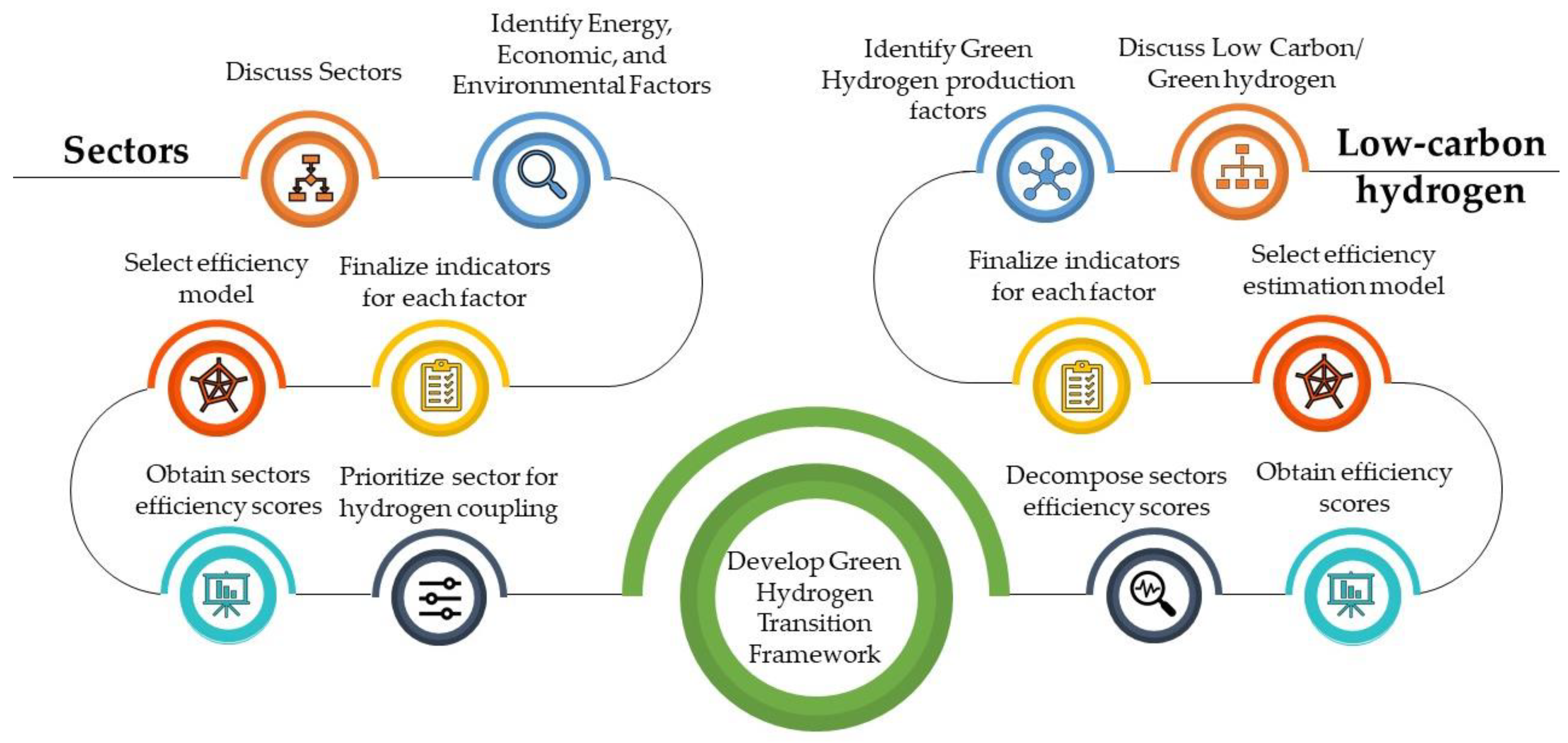

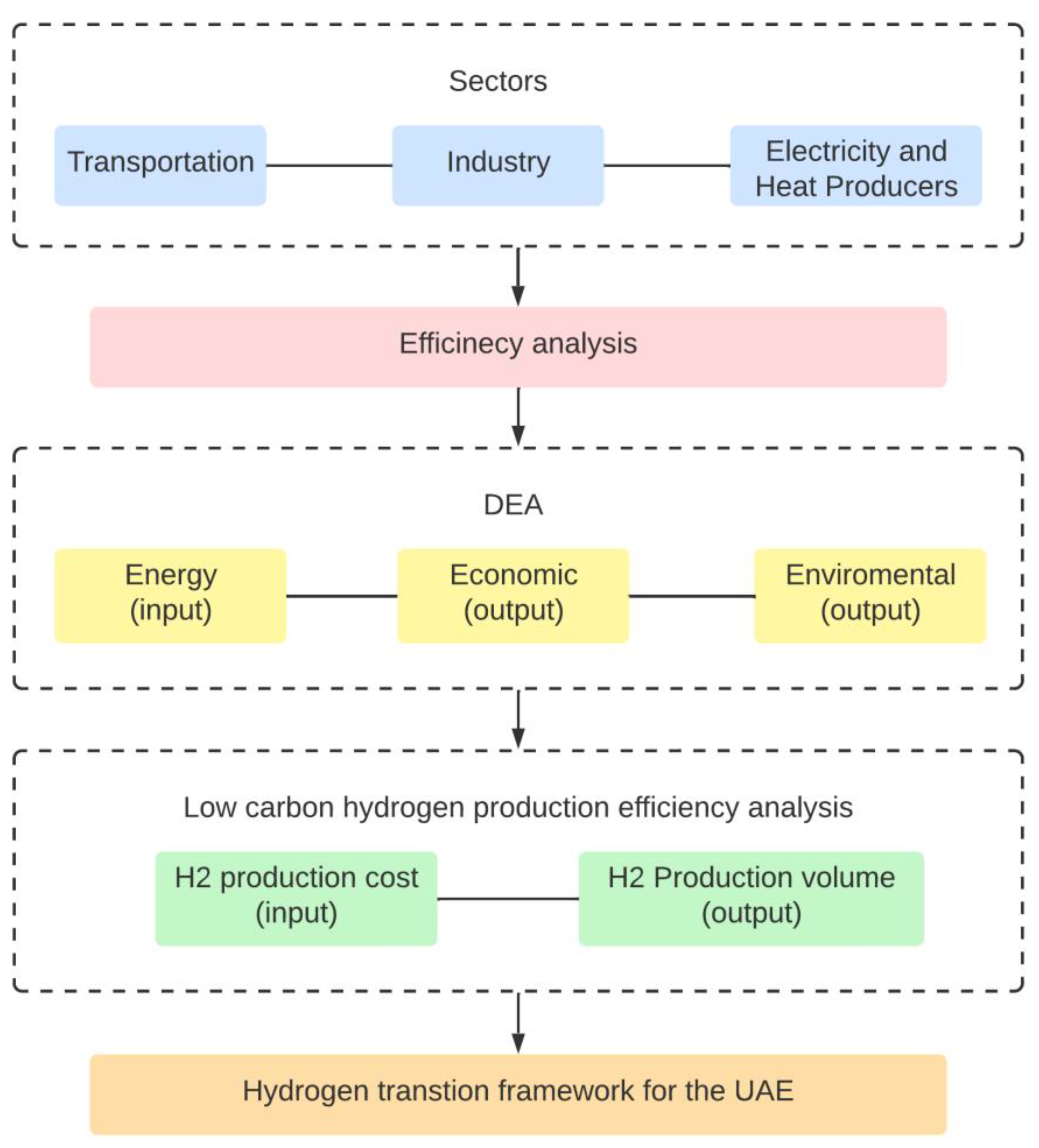
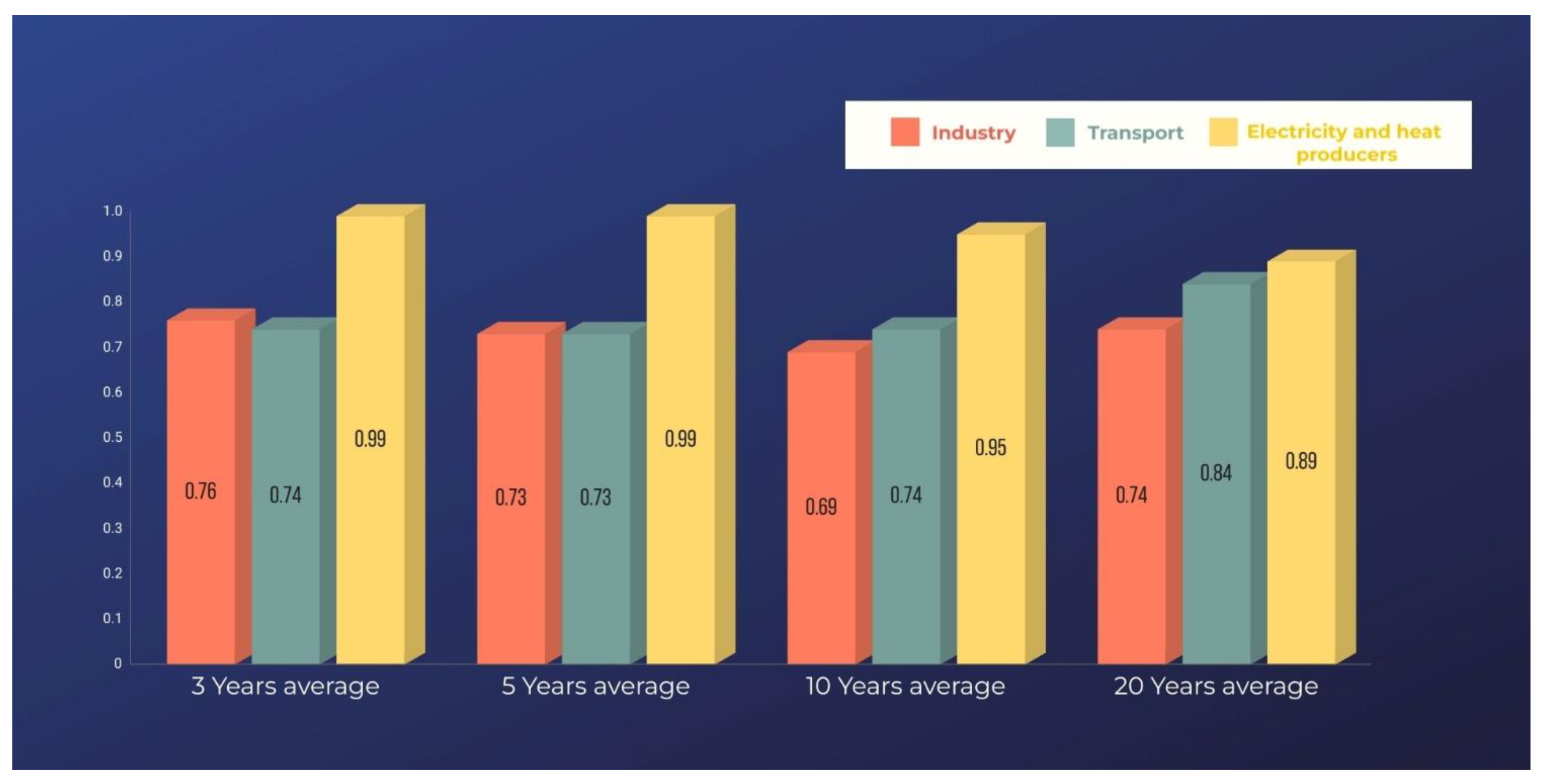


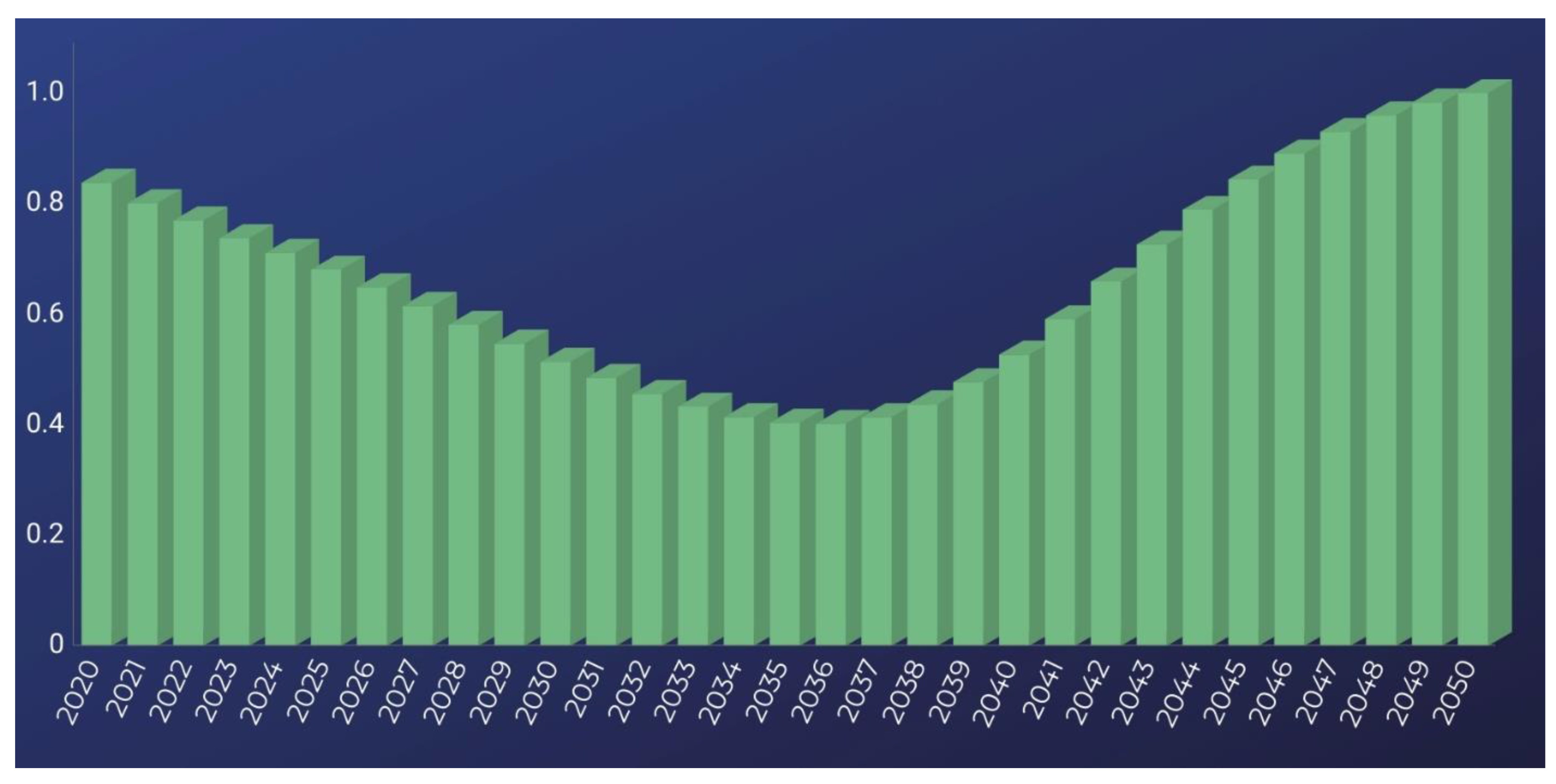
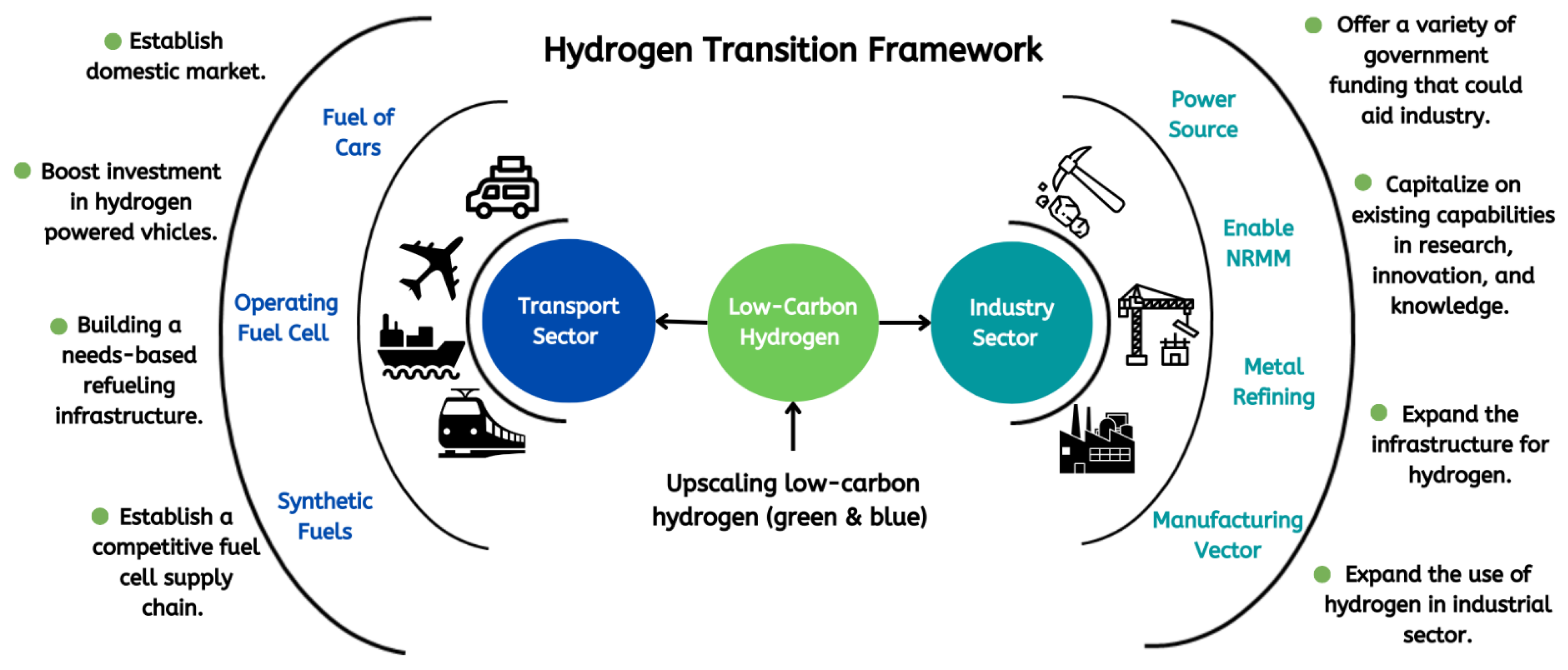
| Sectors | Total Final Consumption (TJ) | Sector GDP Contribution (Billion USD) | CO2 Emissions by Sector (mt CO2) | |
|---|---|---|---|---|
| Industry | Mean | 1,021,346.5 | 147.45 | 57.65 |
| Std. Dev | 300,881.02 | 28.28 | 17.22 | |
| Min. | 606,997 | 90.24 | 34 | |
| Max. | 1,459,132 | 181.81 | 83 | |
| Transport | Mean | 407,791.64 | 19.67 | 29.2 |
| Std. Dev | 100,384.21 | 2.60 | 7.08 | |
| Min. | 226,644 | 14.88 | 16 | |
| Max. | 577,048 | 26.03 | 41 | |
| Electricity and heat producers | Mean | 101,964.04 | 7.41 | 58.75 |
| Std. Dev | 35,234.752 | 2.89 | 12.16 | |
| Min. | 39,107 | 3.21 | 32 | |
| Max. | 148,246.85 | 11.36 | 72 |
| Year | Industry | Transport | Electricity and Heat Producers |
|---|---|---|---|
| 2001 | 0.66 | 0.99 | 0.99 |
| 2002 | 0.69 | 0.96 | 1.00 |
| 2003 | 0.77 | 0.94 | 0.77 |
| 2004 | 0.87 | 1.00 | 0.77 |
| 2005 | 0.92 | 0.94 | 0.78 |
| 2006 | 1.00 | 0.95 | 0.77 |
| 2007 | 0.88 | 0.97 | 0.79 |
| 2008 | 0.82 | 0.94 | 0.66 |
| 2009 | 0.67 | 0.97 | 0.89 |
| 2010 | 0.66 | 0.72 | 0.84 |
| 2011 | 0.69 | 0.74 | 0.90 |
| 2012 | 0.65 | 0.75 | 0.89 |
| 2013 | 0.64 | 0.70 | 0.90 |
| 2014 | 0.67 | 0.74 | 0.92 |
| 2015 | 0.64 | 0.82 | 0.97 |
| 2016 | 0.64 | 0.73 | 1.00 |
| 2017 | 0.71 | 0.70 | 0.98 |
| 2018 | 0.85 | 0.74 | 0.98 |
| 2019 | 0.74 | 0.79 | 1.00 |
| 2020 | 0.70 | 0.69 | 0.98 |
Publisher’s Note: MDPI stays neutral with regard to jurisdictional claims in published maps and institutional affiliations. |
© 2022 by the authors. Licensee MDPI, Basel, Switzerland. This article is an open access article distributed under the terms and conditions of the Creative Commons Attribution (CC BY) license (https://creativecommons.org/licenses/by/4.0/).
Share and Cite
Ibrahim, M.D.; Binofai, F.A.S.; Mohamad, M.O.A. Transition to Low-Carbon Hydrogen Energy System in the UAE: Sector Efficiency and Hydrogen Energy Production Efficiency Analysis. Energies 2022, 15, 6663. https://doi.org/10.3390/en15186663
Ibrahim MD, Binofai FAS, Mohamad MOA. Transition to Low-Carbon Hydrogen Energy System in the UAE: Sector Efficiency and Hydrogen Energy Production Efficiency Analysis. Energies. 2022; 15(18):6663. https://doi.org/10.3390/en15186663
Chicago/Turabian StyleIbrahim, Mustapha D., Fatima A. S. Binofai, and Maha O. A. Mohamad. 2022. "Transition to Low-Carbon Hydrogen Energy System in the UAE: Sector Efficiency and Hydrogen Energy Production Efficiency Analysis" Energies 15, no. 18: 6663. https://doi.org/10.3390/en15186663
APA StyleIbrahim, M. D., Binofai, F. A. S., & Mohamad, M. O. A. (2022). Transition to Low-Carbon Hydrogen Energy System in the UAE: Sector Efficiency and Hydrogen Energy Production Efficiency Analysis. Energies, 15(18), 6663. https://doi.org/10.3390/en15186663







